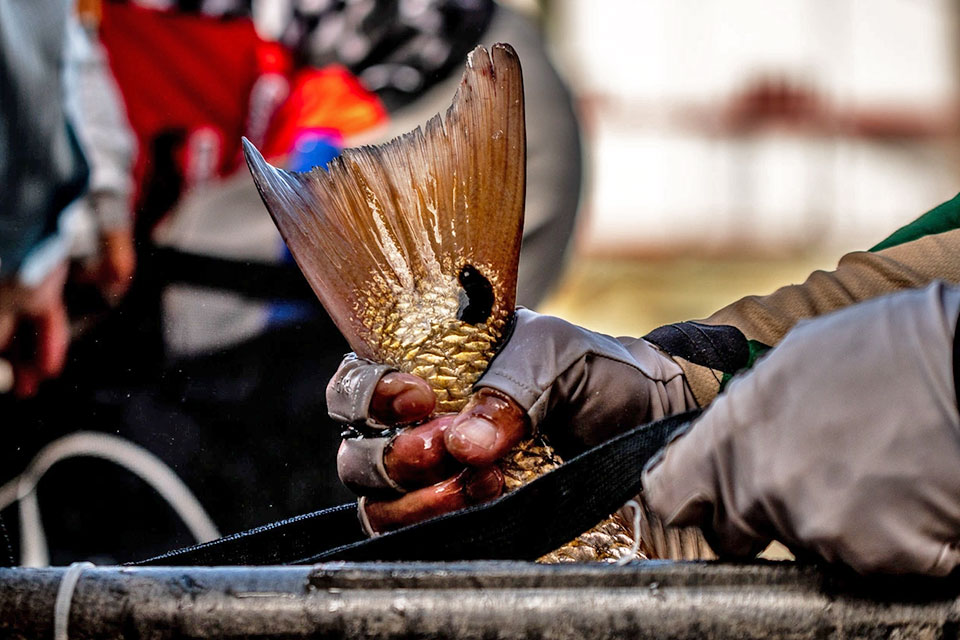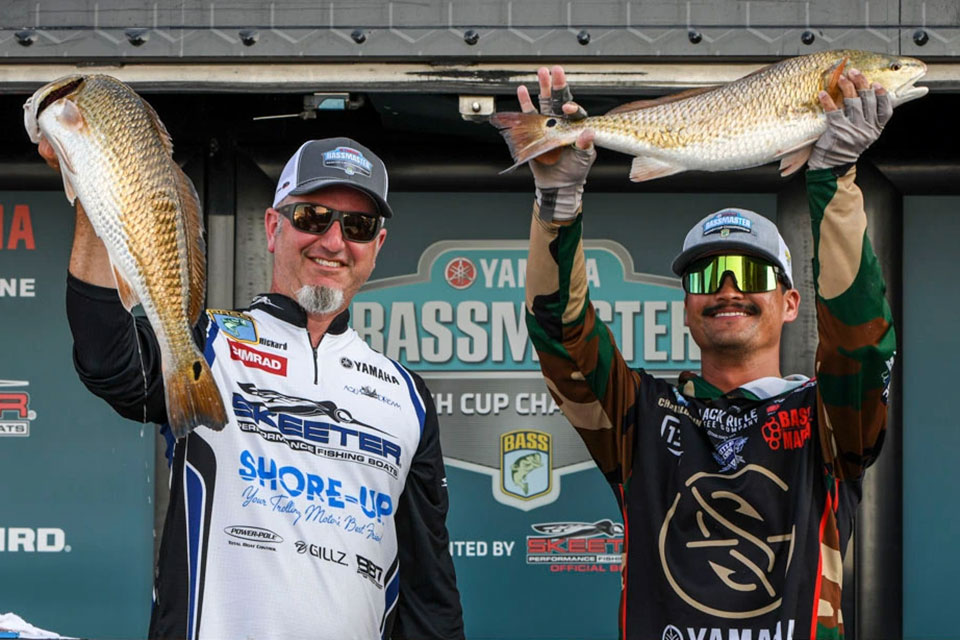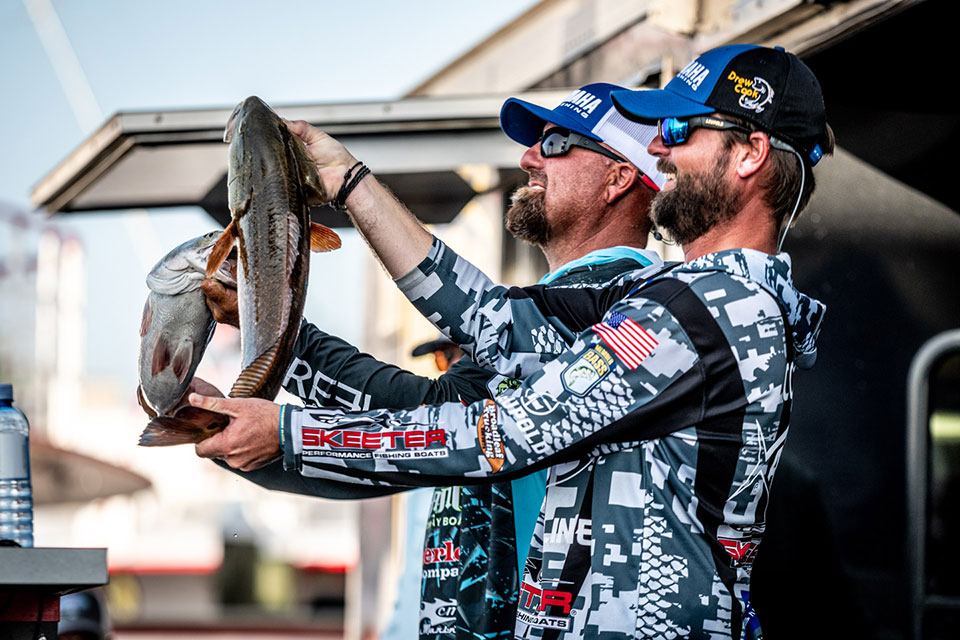
PORT ARANSAS, Texas — Redfish are famous for their tails, the tales of which are growing the sport.
Saltwater photographers and artists base their life’s work on the eye-spotted tails that often stick out of the water. Tailing, as it’s known among redfish aficionados, stirs great emotion among anglers, and certainly those professionals who competed in this month’s Yamaha Bassmaster Redfish Cup Championship presented by Skeeter.
“I don’t care how many redfish you catch, the moment you see that flag come up out of the water, it just does something that gets you so excited,” said Ryan Rickard, who partnered with B.A.S.S. pro Chris Zaldain to post a second-place finish after winning together last year. “It’s almost like buck fever in hunting. It’s redfish fever.”
Two 50-year-old redfish pros from Louisiana, Eddie Adams and Sean O’Connell, who’ve been hot for the species for years, won the $75,000 first prize after catching 48 pounds, 3 ounces over three days.

Five redfish teams qualified for the event, and there were five more redfish pros teamed with a Bassmaster Elite Series angler. The Elites left impressed with their salty brethren, and the redfish anglers were similarly excited for the competition set up under the B.A.S.S. umbrella.
“The stage that we were fishing and the platform that B.A.S.S. created is unparalleled by anything I’ve ever fished in redfishing,” O’Connell said. “This brought redfishing to a new stage, and I can’t thank B.A.S.S. enough.”
There are a number of pro redfish circuits along the U.S. coasts, the Professional Redfish League, Elite Redfish Series and Power-Pole Pro Redfish Tour. Like O’Connell, a number of the redfish pros said they were thrilled for a chance at the big payouts. All the participants earned a paycheck while gaining exposure for themselves and sponsors with the coverage on Bassmaster.com and 7 1/2 hours of live TV coverage on FS1.
Barnie White, of Brewton, Ala., finished fifth with teammate Dwayne Mills, and he said he thoroughly enjoyed his week. “I’m going to do my all to get back next year,” he said. “This was pretty special.”

During the weigh-in at Fisherman’s Wharf, Rickard spoke of how he and Zaldain created a bond and came close to defending their title. If not for the demanding Elite schedule, Zaldain said he might take up Rickard’s offer to compete in more redfish events.
Another Elite having his eyes opened to the sport was Drew Cook, who won his first Elite event in 2022. He said he had a great time teaming with local pro Kevin Akin and finishing third. Cook left wanting more.
“I will definitely not pass up the opportunity to go again, especially if we get to look at them, because that was awesome,” said Cook, who saw some tailing action. “I love sight fishing anyway. Once you see that garnet fish just floating around, it’s amazing. The one I caught (Sunday) on LIVE was just perfect.”
Akin, who guided for the bronze beasts around Corpus Christi for years, wasn’t surprised that Cook might be hooked. He said redfish get deep in anglers’ souls, that the telltale tail creates a tremendous draw to return.
“The tail of a redfish is what drives people to catch them,” Akin said. “There’s a bunch of redfish anglers, whether its new guys or old guys, who look down the shallow bank and see a school of redfish coming down, tails up, or see a single just up there waving at you, it’s something that just never gets old.

“I’ve been doing this a long time now, and still when I see one, I get excited. If you think as many redfish as we’ve caught over the years, we wouldn’t get excited, but you see one and it’s ‘Tail! Tail! Tail!’”
Redfish were once considered as a trash fish, but commercial interest began in the 1980s with New Orleans’ chef Paul Prudhomme’s blackened Cajun recipe. They became so popular, regulations had to be set. Angling for the now desirable species began in earnest, as did competitions, and now many experience Rickard’s aforementioned redfish fever.
“That tail makes the drive of wanting to continue the sport just so high for all of us redfish guys,” he said. “It’s not something you see every day. That’s so unique to see that flag come up and see that spot on their tail.”
From his years guiding, Akin said he knows he’s hooked a number of clients on becoming redfish anglers.
“When people see a redfish in the water, their excitement level was so high, even if they had never seen one before,” he said. “You can turn a guy who is not that much of a fisherman, and didn’t really want to fish, but you let him start seeing fish and throwing to them and catching them, before it’s over you can get him to chase redfish for the rest of his life.”
Feeding is why redfish tails stick up, giving away their location. With hard mouths, they push along the bottom, rooting through grass and shell, digging up tasty morsels.
“The key to tailing redfish is the forage,” Rickard said. “They’re feeding on small crabs, crustaceans and shrimp, the stuff that’s down in the grass. If it’s pilchards or mullet, their face will be up.”
Redfish can often be seen slowly rolling through an area, backs then tails breaking the waterline, the telltale sign they’re hunting.
“They’re always on the prowl. They’re always looking around stealthily,” Rickard said. “It’s sometimes difficult to determine the difference between a mullet and redfish. Mullet will be very flickery, a redfish will be very snaky. That snaking will be the difference.”
On his first day of practice, Cook, among the best sight-fisherman on the Elite Series, said he cast to movement that ended up being mullet. He quickly learned the difference and was stoked about sighting a fish that Akin caught.
In the sport, the trick is to catch a fish just under the upper end of the 20- to 28-inch slot. Those 27 3/4-inch fish most times are the heaviest, and with a limit of only two, every ounce counts. A not widely-known facet is a true unicorn, a redfish just under the slot with its tail abraded. Depending on where they live, some redfish tails can be worn away, similar to a bedding bass that rubs away its caudal fin.
“Those fish that live in the grass all year wear their tails out,” Akin said. “They’re constantly beating their tails. Time and pressure, they rub it on the grass, and it gets shorter.”
Akin said redfish can lose a quarter of an inch to a half an inch, which would make one close to the slot weigh much better than those with perfectly formed tails, which are usually fresh from the Gulf. Rickard confirmed the phenomena.
“There’s all kind of stuff that happens when they sit like that chewing in the grass,” he said. “They get nipped by pinfish. They’re wagging in oysters, wagging in barnacles. It’s just ticking away, ticking away.”
“If you looked at our first fish yesterday, that 8-plus, the tip of that tail was really grazed out.”
Adams and O’Connell wished a 9 1/2-pounder they landed had worn its tail a quarter-inch. They had to release it and miss out on a pound upgrade, but winning makes missing out on a dream fish way easier to take.
In his practice before his last tournament in Louisiana, Rickard said he caught what he believes might be the biggest slot fish he’s seen, a 11 3/4. Louisiana is known for having great food, for humans and redfish.
“Those fat ones get really lazy,” Rickard said. “The local fish tend to be a lot more red or bronze, and they’re a lot fatter because they’re not moving. They stay there and just eat. The fish that just come in from the Gulf and are pale and white, their metabolism is up and they’re just really skinny fish.”
The dream fish are rare — unicorns as one pro put it — but the continued pursuit is one of the reasons why anglers feed their redfish fever.





